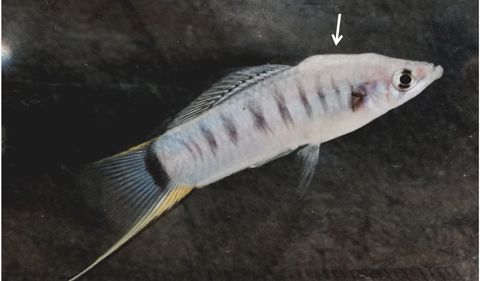Dr. Molly Morris, Professor of Biological Sciences, and her students and collaborators published an article on the role of appetite regulation in obesity and metabolic disorders in swordtail fish in an August 2018 article in Zebrafish.
“There is a growing interest in the role of appetite regulation in obesity and metabolic disorders, suggesting that a better understanding of both the genetic and developmental influences on appetite is needed. Appetite regulates feeding behaviors that result in food intake and that in turn can increase growth rates and fat deposition. However, understanding the key biological inputs of appetite regulation and their implications for body weight regulation is quite complicated,” the authors write in their introduction.
“A model system with homologous gene-by-environment interactions involved in feeding but with fewer confounding variables as found in mammalian systems could provide valuable insights into the regulation of appetite. In addition, identifying measures of appetite, or the motivation to eat, in these model systems will allow for the study of appetite independent of food intake. Indications for a measure representing appetite would include demonstrations that the behavior is related to food intake, growth, and fat deposition, and endures over time.”
The article was titled Feeding Rates in the Swordtail Fish Xiphophorus multilineatus: A Model System for Genetic Variation in Nutritional Programming. Morris’ co-authors from OHIO are R.J. Friebertshauser, M. Zupi M, Melissa Liotta, and N. Kleinas, along with G. Dunn from Washington and Jefferson College, and Oscar Rios-Cardenas from Mexico’s Instituto de Ecología.
Abstract: A better understanding of the role of appetite regulation in obesity and metabolic disorders requires consideration of both genetic and developmental influences on appetite. Previously we detected genetic differences in responses to nutritional programming (e.g., the permanent influence that nutrition in early life has on the physiological and metabolic states in adults) on a presumed measure of appetite (feeding rate) in the swordtail fish Xiphophorus multilineatus. In this study we validate that feeding rate is a good measure of appetite, by first demonstrating that it is repeatable and correlated with food consumed when controlling for body size. Second, we detected a significant positive correlation between juvenile growth rates and feeding rates measured in adult males, when growth has ceased. In addition, feeding rates explained significant variation in the size of the nuchal hump, a fat deposit that develops after sexual maturity. Finally, we show that the feeding rates of “courter” males were significantly greater than “sneaker” males, alternative reproductive tactics that are influenced by variation in the Mc4r gene on the Y-chromosome. Our results suggest that examining feeding rate in X. multilineatus could provide valuable insights into how nutritional programming influences appetite independently from food intake, as well as insights into the mechanisms that produce the correlation between delayed maturation and faster growth rates of the courter males as compared with the sneaker males that mature early and grow slower in this species.
Ríos-Cardenas O, Bono L, Morris MR (2018) Frequency-dependent selection and fluctuations around an equilibrium for alternative reproductive tactics in a swordtail. Animal Behaviour 140, 19-28.




















Comments